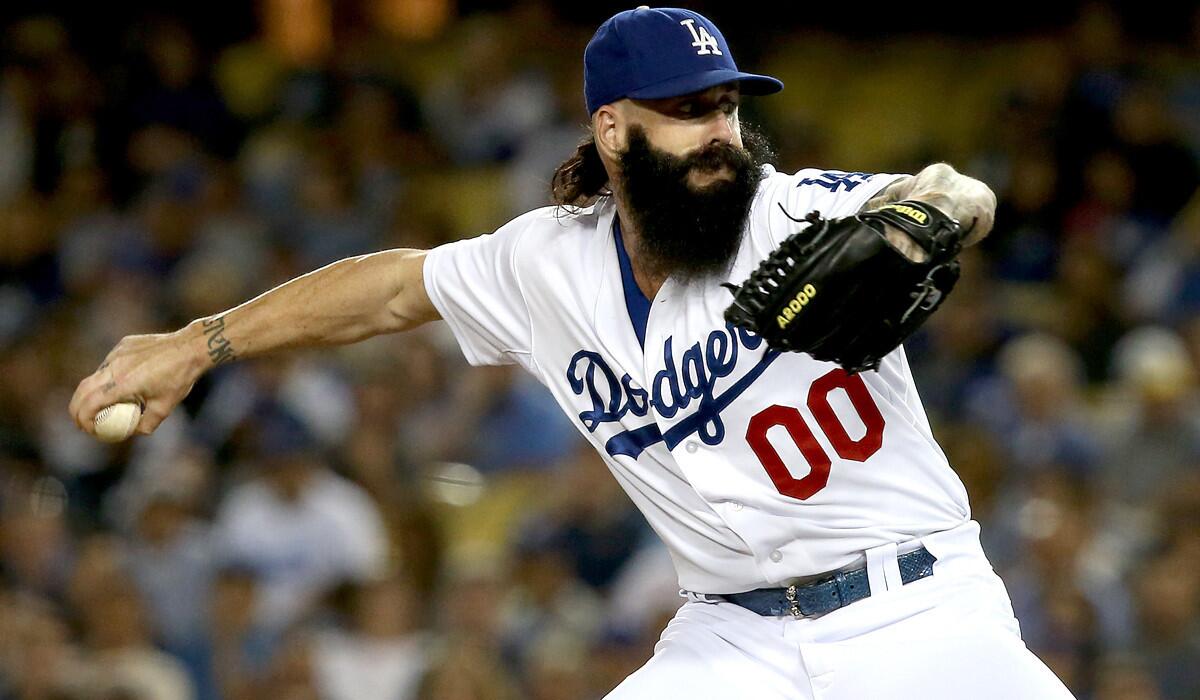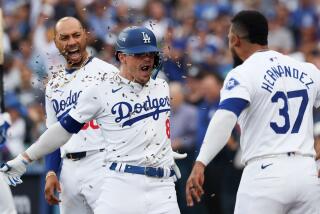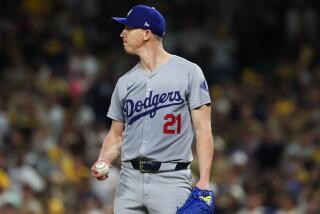Something in the Dodgers’ bullpen setup is shaky

- Share via
Don Mattingly sounded almost wistful. He had his worries heading into the playoffs last year — his continued employment foremost among them — but he knew exactly what he would do when the Dodgers held a lead late in the game.
“When we got to the eighth, at the end of the season, it was Brian Wilson. We didn’t have any decision to make,” Mattingly said Monday. “It hasn’t been quite that simple this year.”
The Dodgers have five games left before the playoffs and no firm idea of how to get the ball to closer Kenley Jansen. The 2013 tag team of Wilson and Jansen has deteriorated into setup-man auditions in these final days of the regular season.
Rookie Pedro Baez, who was a third baseman two years ago, is in the setup mix. So is Paco Rodriguez, who led all major league left-handers in appearances as a rookie last season before the Dodgers banished him to the minors this season.
“We’re trying to match up guys as best we can in the seventh and eighth innings,” Mattingly said, “to get the ball to Kenley.”
That can be a good way to go. Of the two relievers that have been reliable all season, Jansen is the closer, and J.P. Howell is the left-hander available to neutralize left-handed enemy bats.
“You’ve seen him used in the sixth, seventh or eighth inning,” pitching coach Rick Honeycutt said. “There’s a part of the lineup you get to and you say this is his section and you let him have it.”
The Dodgers paid big money — $20 million in all — for former All-Star closers Wilson, Brandon League and Chris Perez — to serve as the bridge to Jansen. That bridge has been shaky, at best.
Jansen has been terrific. He is not the reason the Dodgers’ starters rank second in the National League in earned-run average and the Dodgers’ relievers rank 12th. He is not the reason the starters have allowed a .291 on-base percentage entering play Monday and the relievers a .321 on-base percentage — the greatest increase from starters to relievers of any pitching staff in the league.
On Saturday, Wilson faced five batters, retired two, then told reporters his high-80s velocity should not be cause for alarm, because last year “when I decided to bring it up to 95 was the playoffs, and not really any time before that.”
On Monday afternoon, Honeycutt said the Dodgers would not mind seeing Wilson pick up his velocity during this series, against the San Francisco Giants.
“Brian is obviously a veteran guy that has pitched in these situations,” Honeycutt said. “He has a plan. Here’s a great series where he needs to be on top of his game and show us where he’s at.”
Wilson threw 11 pitches on Monday night, five of which hit 90 mph. He walked Buster Posey on five pitches, then fell behind Pablo Sandoval 3-and-0 before Sandoval grounded out.
So much of how the Dodgers construct their postseason staff will depend on whether Hyun-Jin Ryu can start — and, if so, what the team reasonably can expect out of him. Carlos Frias made his major league debut last month — after eight years in the minor leagues — and he could become the long man on the playoff roster.
Ned Colletti, the general manager, said the Dodgers would consider the three youngsters — Baez, Rodriguez and Frias — for the playoff roster.
“Absolutely,” Colletti said. “I think the team we played last year in the [NL Championship Series] had some young pitching.”
The St. Louis Cardinals had five rookies on their October staff, including phenom Michael Wacha, closer Trevor Rosenthal and setup man Carlos Martinez. Other than Wilson and Howell, the Dodgers’ best reliever last fall was rookie Chris Withrow, who underwent Tommy John surgery in June.
However, under Colletti, the Dodgers prefer not to entrust such prominent roles to youngsters. The signings of Perez and Wilson left no room on the staff for Rodriguez, who held opponents to a .164 batting average last season and ranked sixth among NL relievers in WHIP. It also left no room for the Dodgers to shuttle relievers between the majors and minors — the better to ride the hot hand — because they did not wish to risk losing the veterans on waivers.
“When you have veteran experience, that counts too. That has value to it,” Colletti said.
“We want to give our younger guys as much time as possible to be ready. We had good arms, but we had inexperience. In the best-case scenario, you break them in in a deliberate but not forced situation. When you look at our bullpen today, it’s got a mixture in it, which is what you hoped it would have by the time we got to the end of the season.”
This might not be the best mixture. But, as Donald Rumsfeld might say, you go to the playoffs with the bullpen you have, not the bullpen you might want. It’s go time.
Twitter: @BillShaikin
More to Read
Are you a true-blue fan?
Get our Dodgers Dugout newsletter for insights, news and much more.
You may occasionally receive promotional content from the Los Angeles Times.











